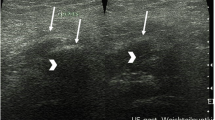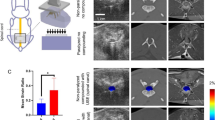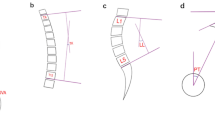Abstract
Study design
Prospective observational study.
Objective
To evaluate pelvic MRI muscle signal changes and their association with early heterotopic ossification (HO) in patients with spinal cord injuries.
Setting
National Spinal Injuries Unit, Stoke Mandeville, UK.
Methods
Forty patients were imaged with at least two interval magnetic resonance (MR) studies of the pelvis in the first 6 months following a spinal cord injury. Scans were reviewed and scored for heterotopic ossification, muscle signal change and extent of muscle involvement.
Results
Muscle signal change was present in 28 (70%) on the initial MRI and 31 (77%) by the second study. Six patients developed MR changes of prodromal or immature heterotopic ossification (15%). No restricted diffusion was demonstrated and no patient developed mature HO. Patients developing MR changes of early HO were more likely to have grade 3 muscle changes.
Conclusion
Increased T2 muscle signal is common following cord injury, is frequently progressive in the subacute period and is associated with complete injury and early MR signs of heterotopic ossification.
Similar content being viewed by others
Log in or create a free account to read this content
Gain free access to this article, as well as selected content from this journal and more on nature.com
or
Data availability
The datasets generated and/or analysed during the current study are available from the corresponding author on reasonable request.
References
Bravo-Payno P, Esclarin A, Arzoz T, Arroyo O, Labarta C. Incidence and risk factors in the appearance of heterotopic ossification in spinal cord injury. Spinal Cord. 1992;30:740–5.
Colachis SC, Clinchot DM. The association between deep venous thrombosis and heterotopic ossification in patients with acute traumatic spinal cord injury. Spinal Cord. 1993;31:507–12.
Prakash V. Radionuclide assessment of heterotopic ossification in spinal cord injury patients. J Am Paraplegia Soc. 1983;6:10–2.
Wittenberg RH, Peschke U, Bötel U. Heterotopic ossification after spinal cord injury. Epidemiology and risk factors. J Bone Jt Surg Br. 1992;74:215–8.
Reznik JE, Biros E, Marshall R, Jelbart M, Milanese S, Gordon S, et al. Prevalence and risk-factors of neurogenic heterotopic ossification in traumatic spinal cord and traumatic brain injured patients admitted to specialised units in Australia. J Musculoskelet Neuronal Interact. 2014;14:19–28.
Taly A, Nair K, Kumar MV, Jayakumar P, Vasudev M, Ravishankar D, et al. Heterotopic ossification in non-traumatic myelopathies. Spinal Cord. 1999;37:47–9.
Goodman TA, Merkel PA, Perlmutter G, Doyle MK, Krane SM, Polisson RP. Heterotopic ossification in the setting of neuromuscular blockade. Arthritis Rheum. 1997;40:1619–27.
Minaire P, Betuel H, Girard R, Pilonchery G. Neurologic injuries, paraosteoarthropathies, and human leukocyte antigens. Arch Phys Med Rehabil. 1980;61:214–5.
van Kuijk A, Geurts A, van Kuppevelt H. Neurogenic heterotopic ossification in spinal cord injury. Spinal Cord. 2002;40:313–26.
Vanden Bossche L, Vanderstraeten G. Heterotopic ossification: a review. J Rehabil Med. 2005;37:129–36.
Garland DE, Alday B, Venos KG. Heterotopic ossification and HLA antigens. Arch Phys Med Rehabil. 1984;65:531–2.
Citak M, Suero EM, Backhaus M, Aach M, Godry H, Meindl R, et al. Risk factors for heterotopic ossification in patients with spinal cord injury: a case-control study of 264 patients. Spine. 2012;37:1953–7.
Banovac K, Gonzalez F. Evaluation and management of heterotopic ossification in patients with spinal cord injury. Spinal Cord. 1997;35:158–62.
Cassar-Pullicino VN, McClelland M, Badwan DA, McCall IW, Pringle RG, el Masry W. Sonographic diagnosis of heterotopic bone formation in spinal injury patients. Paraplegia. 1993;31:40–50.
Svircev JN, Wallbom AS. False-negative triple-phase bone scans in spinal cord injury to detect clinically suspect heterotopic ossification: a case series. J Spinal Cord Med. 2008;31:194–6.
Rosteius T, Suero EM, Grasmücke D, Aach M, Gisevius A, Ohlmeier M, et al. The sensitivity of ultrasound screening examination in detecting heterotopic ossification following spinal cord injury. Spinal Cord. 2017;55:71–3.
Behery OA, Dai AZ, McLaurin TM. Posttraumatic heterotopic ossification of the hip. J Orthop Trauma. 2018;32 Suppl 1:S18–9.
Wick L, Berger M, Knecht H, Glücker T, Ledermann HP. Magnetic resonance signal alterations in the acute onset of heterotopic ossification in patients with spinal cord injury. Eur Radiol. 2005;15:1867–75.
Banovac K. The effect of etidronate on late development of heterotopic ossification after spinal cord injury. J Spinal Cord Med. 2000;23:40–4.
Pakos EE, Ioannidis JPA. Radiotherapy vs. nonsteroidal anti-inflammatory drugs for the prevention of heterotopic ossification after major hip procedures: a meta-analysis of randomized trials. Int J Radiat Oncol Biol Phys. 2004;60:888–95.
de l’Escalopier N, Salga M, Gatin L, Genêt F, Denormandie P. Resection of heterotopic ossification around the hip after trauma. EFORT Open Rev. 2019;4:263–8.
Hauptfleisch J, Meagher TM, Hughes RJ, Singh JP, Graham A, López de Heredia L. Interobserver agreement of magnetic resonance imaging signs of osteomyelitis in pelvic pressure ulcers in patients with spinal cord injury. Arch Phys Med Rehabil. 2013;94:1107–11.
López de Heredia L, Hauptfleisch J, Hughes R, Graham A, Meagher TMM. Magnetic resonance imaging of pressure sores in spinal cord injured patients: accuracy in predicting osteomyelitis. Top Spinal Cord Inj Rehabil. 2012;18:146–8.
Greenspan L, McLellan BA, Greig H. Abbreviated injury scale and injury severity score: a scoring chart. J Trauma. 1985;25:60–4.
Freebourn TM, Barber DB, Able AC. The treatment of immature heterotopic ossification in spinal cord injury with combination surgery, radiation therapy and NSAID. Spinal Cord. 1999;37:50–3.
Mujtaba B, Taher A, Fiala MJ, Nassar S, Madewell JE, Hanafy AK, et al. Heterotopic ossification: radiological and pathological review. Radiol Oncol. 2019;53:275–84.
Ohlmeier M, Suero EM, Aach M, Meindl R, Schildhauer TA, Citak M. Muscle localization of heterotopic ossification following spinal cord injury. Spine J. 2017;17:1519–22.
Arduini M, Mancini F, Farsetti P, Piperno A, Ippolito E. A new classification of peri-articular heterotopic ossification of the hip associated with neurological injury: 3D CT scan assessment and intra-operative findings. Bone Jt J. 2015;97-B:899–904.
Ledermann HP, Schweitzer ME, Morrison WB. Pelvic heterotopic ossification: MR imaging characteristics. Radiology. 2002;222:189–95.
Funding
This project was in receipt of funding from the Davenport Award, Buckinghamshire NHS Trust Charitable Fund and also received NHS Portfolio support funding.
Author information
Authors and Affiliations
Contributions
The authors confirm that all authors have made substantial contributions to all four categories established by the International Committee of Medical Journal Editors (http://www.icmje.org) to include: (1) conception and design, or acquisition of data, or analysis and interpretation of data, (2) drafting the article or revising it critically for important intellectual content, (3) final approval of the version to be published, and (4) agree to be accountable for all aspects of the work if questions arise related to its accuracy or integrity.
Corresponding author
Ethics declarations
Conflict of interest
The authors declare that they have no conflict of interest.
Ethical approval
We certify that all applicable institutional and governmental regulations concerning the ethical use of patients were followed during the course of this research.
Additional information
Publisher’s note Springer Nature remains neutral with regard to jurisdictional claims in published maps and institutional affiliations.
Supplementary information
Rights and permissions
About this article
Cite this article
McKean, D., Ather, S., Gandhi, A. et al. Pelvic MRI in spinal cord injury patients: incidence of muscle signal change and early heterotopic ossification. Spinal Cord 59, 635–641 (2021). https://doi.org/10.1038/s41393-020-00539-8
Received:
Revised:
Accepted:
Published:
Issue date:
DOI: https://doi.org/10.1038/s41393-020-00539-8



